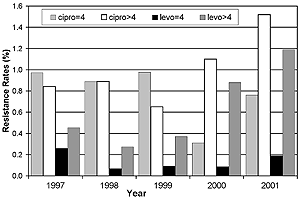Publications
Fluoroquinolone Resistance in Streptococcus pneumoniae in
Canada - Are We Surveying Just the Tip of the Iceberg? P. TANG,
K. GREEN, A. MCGEER, K. WEISS, D. CHURCH, R. DAVIDSON, D. HOBAN, P.
KIBSEY, M. KUHN, B. TOYE, S. PONG-PORTER, D.E. LOW. Toronto Medical
Labs/Mount Sinai Hospital, Toronto, ON, Canada and Canadian Bacterial
Surveillance Network, Toronto, ON, Canada.
Background:
The increasing rates of ß-lactam resistance (R) in S. pneumoniae
(SP) over the past 15 years has led to the use of newer agents such
as the respiratory fluoroquinolones (FQs). Inevitably, the emergence
of R to FQs has been observed in the past few years. Current recommendations
for surveillance test for levofloxacin (levo) R.
Methods:
Between 1997-2001, we tested 9531 SP isolates from across Canada
for susceptibility to FQs: ciprofloxacin (cipro) MIC >
4 mg/L, levo, gatifloxacin (gati) and moxifloxacin (moxi).
Results:
Cumulative rates of R were 1.8%, 0.7%, 0.6% and 0.3% for cipro,
levo, gati and moxi respectively. R developed in a step-wise fashion
with cipro>levo>gati>moxi. From 1997-2001, the cipro-R strains became
levo-R. As this population expanded, a new population of cipro-R
isolates emerged in 2001. We do not capture this population using
levo R or levo intermediate susceptibility as breakpoints.

Conclusions:
Surveillance for levo R in SP reveals only a fraction of the population
capable of developing R to the other respiratory FQs. We suggest
the use of cipro MIC > 4 mg/L as the new marker for FQ
R. Alternatively, screening for first-step mutations in parC
and gyrA would also reveal the true magnitude of the FQ R
problem.
42nd INTERSCIENCE CONFERENCE ON ANTIMICROBIAL AGENTS AND CHEMOTHERAPY
(ICAAC), San Diego, California, USA, September 29, 2002. 3:00pm
to 4:30pm.

ęCopyright 2002 Last Modified
|